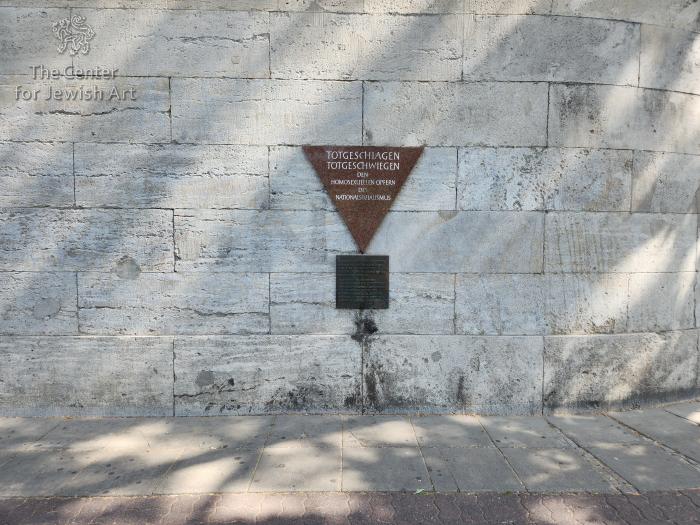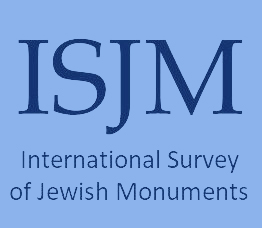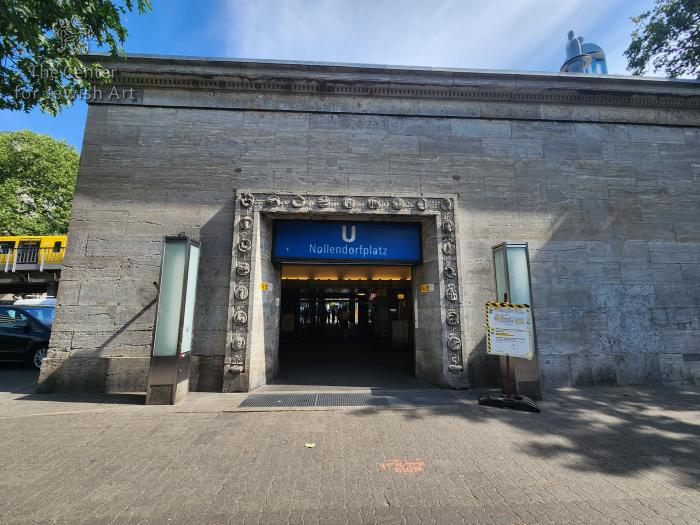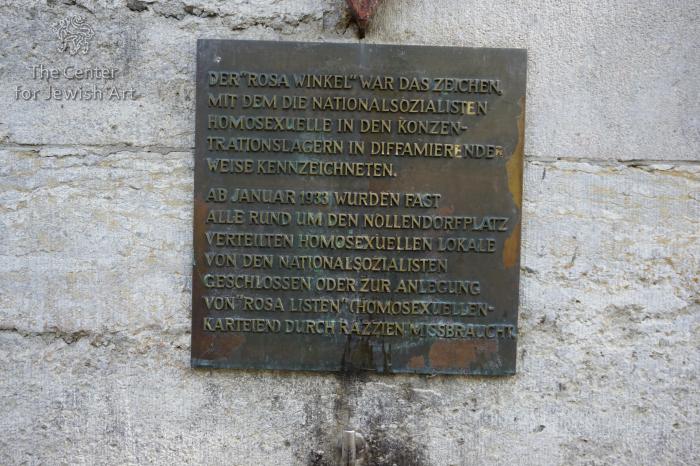Obj. ID: 50390 Holocaust Memorial to LGBTQ Victims at Nollendorfplatz Station in Berlin, Germany, 1989

Memorial Name
Memorial to the Homosexual Victims of Nazism
Who is Comemmorated?
LGBTQ Victims of nazi repression and murder
Description:
At the Nollendorfplatz U-Bahn station, a large inscribed pink stone inverted triangle is set on an exterior wall, with an inscription in German. Below it is affixed a rectangular metal plaque with more historical information about the persecution by the Nazis of LGBTQ individuals.
Inscription
Upper Plaque (German)
TOTGESCHLAGEN
TOTGESCHWIEGEN
DEN
HOMOSEXUELLEN OPFERN
DES
NATIONALSOZIALISMUS
Translation: Slaughtered Silenced – To the Homosexual Victims of National Socialism
Lower Plaque (German)
DER “ROSA WINKEL” WAR DAS ZEICHEN
MIT DEM DIE NATIONALSOZIALISTEN
HOMOSEXUELLE IN DEN KONZEN-
TRATIONSLAGERN IN DIFFAMIERENDER
WEISE KENNZEICHNETEN.
AB JANUAR 1933 WURDEN FAST
ALLE RUND UM DEN NOLLENDORFPLATZ
VERTEILTEN HOMOSEXUELLEN LOKALE
VON DEN NATIONALSOZIALISTEN
GESCHLOSSEN ODER ZUR ANLEGUNG
VON ‚ROSA LISTEN‘ (HOMOSEXUELLEN-
KARTEIEN) DURCH RAZZIEN MISSBRAUCHT.
Translation: The ‘pink triangle’ was the sign used by the Nazis to stigmatize homosexuals in the concentration camps. Beginning in January 1933, almost all the homosexual bars around Nollendorfplatz were closed by the Nazis or misused for the creation of ‘pink lists’ (homosexual card indexes) through raids.
Commissioned by
[To Be Determined]
Bronze
Each side: 0.9 Meters
Bronze Plaque
Length: 0.4 Meters
Width: 0.4 Meters
The plaque is affixed to the exterior wall of the Nollendorfplatz U-Bahn Station. Nollendorfplatz is at the center of Berlin’s historically gay neighborhood. The plaque was put up in 1989, with a pink triangle commemorating the persecution and murder of members of the LGBTQ+ community (mostly gay men) in the Third Reich. Flowers are often laid in front of it.
“The plaque on Nollendorfplatz was the first to prominently commemorate the homosexual victims of National Socialism in a public space and to acknowledge their history of persecution. Activist groups had demanded the commemorative plaque for more than ten years. In 1989, after initial resistance from the Berlin Transportation Authority (BVG), the plaque was mounted on the outer wall of the Nollendorfplatz subway station. An additional plaque was installed in 1993”. [Queer as German Folk]
Nollendorfplatz was the center of gay nightclub and social life in Berlin in the 1920s and early 1930s, most famously at the Eldorado (there is a plaque at Motzstraße 24), and best known to English-speaking audiences through Christopher Isherwood's "Berlin Stories," the inspiration for the musical Cabaret. Isherwood lived at Nollendorfstrase 17.
The placement of the memorial plaque has inspired many other memorials to the neighborhood’s LGBTQ+ history. Less prominent plaques recall happier times. There is a sign above the organic supermarket at Motzstraße 24, the site of the bar Eldorado in the early 1930s, a hub for Berlin's gay and trans communities. The Magnus pharmacy at Motzstraße 11 is named after Magnus Hirschfeld, the founder of the Homosexual Rights Movement.
The dome of Nollendorfplatz U-Bahn station has been lit in rainbow colors since 2013 as a sign of the neighborhood’s tolerance and diversity. Across the street from the station is a column sculpture erected by the Berlin artist Salomé, ca. 2000. It is a metal pencil in rainbow colors with a pink tip, donated by the landlords of local gay bars.
"1989: Commemorative plaque on Nollendorfplatz in Berlin," Queer as German Folk, https://queerexhibition.org/totgeschwiegen/denkmaeler (accessed July 9, 2023)
"Photo of the Eldorado Club," Holocaust Sources in Context (Everyday Encounters with Fascism), https://perspectives.ushmm.org/item/photo-of-the-eldorado-club/collection/sexuality-gender-and-nazi-persecution (accessed July 9, 2023)












